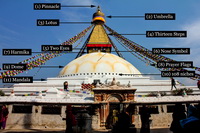

The “great stupa” in Boudhanath is one of the most important stupas in the worldOne of the guide book exlusions that always irked me was the lack of simple information telling me what each part of this great stupa was called. It’s one of the reasons I wrote my own guide to Boudhanath. It’s a simple question that needs answering. Everyone know’s “the eyes”. Those colorful eyes are at best – an easy guess. But what do all the other parts mean? Let’s take a look! The different parts of Boudhanath stupa
So there are the main parts. But what about the stupa as a whole? What is a stupa?A stupa, or Chaitya in Nepal, is said to represent Buddha’s holy mind. Each step thusly showing the way to enlightenment. Throughout history there have been different types of stupa and different ways of constructing them. In this case the Boudhanath stupa has several legends leading to it’s creation. Legends surrounding Boudhanath Stupa
You may also be curious to learn how Boudhanath was named. How are stupas created?Again each stupa seems to be a little different. Tradition dictates that it starts with a square base called the Lion’s Seat. Each of the four sides refer to the four qualities needed to attain enlightenment: Love, Compassion, Joy and Equanimity. The main central area is then filled with sacred artifacts and relics. This may also contain a piece from Buddha himself. In Boudhanath’s case this is said to be from his little finger. Why build a stupa?There are many reasons people build a stupa. From creating a place people can gather to give respect to Buddha a central area people can practice their faith. Many others create stupa’s to either be born again at a higher level eg from peasant to royalty. Others still believe it will give them clairvoyance to understanding Buddhism. Perhaps one of the more popular reasons is to remove all signs of negative karma from ones life by building a stupa. Want to know more? Do read my full guide to Boudhanath to learn more including: the Ajima/Hariti shrine and the Tamang Monastery. If you found this article helpful, insightful or useful I’ve something even better that you can read on your tablet, phone, computer or even if you want to print. Check out the latest and best guidebooks to Nepal. |

Really interesting post, I didnt learn an overly large amount about these when I was in Nepal, just took lots of photos.
Glad you found it interesting
Love this – so fascinating!
I always wondered about stupas and what if everything had a meaning or not. Thanks for answering! Do you know if stupas in other parts of the world have the same meanings?
Hi Alison, It’s probably safer to say this should only hold true in Nepal. That said some of the main parts of the stupa would have similar names all over the world.
Well this deserves some credit. I’m been reading about you for a while and seeing this made me smile. Few people go to ask anyone what the parts of a stupa mean when visiting either in Nepal or anywhere else. Great that so many reading here will now have a reference point.
Thanks John. It was something that I always wondered about myself and few people seemed to know. At least the information about the parts of a stupa is here now!
Just a wonderful article! It’s something I was curious about for a long time. Stupa’s always seemed so mysterious and I never really understood them until reading this. Thanks Dave.
Ha, I’m not sure I understand all the parts still. But at least we know the names :)
Very nice. It’s interesting that stupas differ so much unlike say a mosque or church. I know, different things altogether but interesting how they are built differently depending on the country.
I guess it boils down to who built the stupa. Some people will build a stupa a little differently to others. I chose the Boudhanath stupa as it’s one of the worlds biggest stupas so it made sense that it’s a good choice to name the parts of it as well. I imagine smaller stupas may not have as many sections. Then again someone may have built a very elaborate stupa and added more. What I do know is these are all the names of the main sections at least.